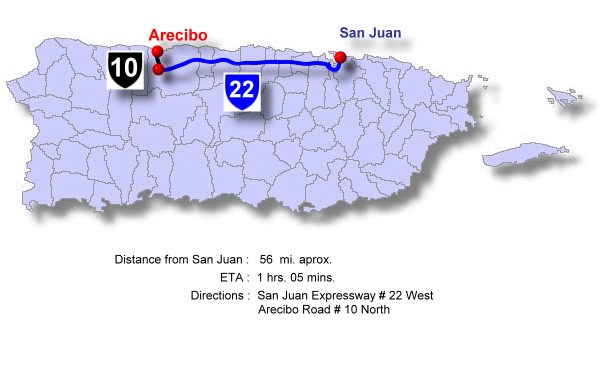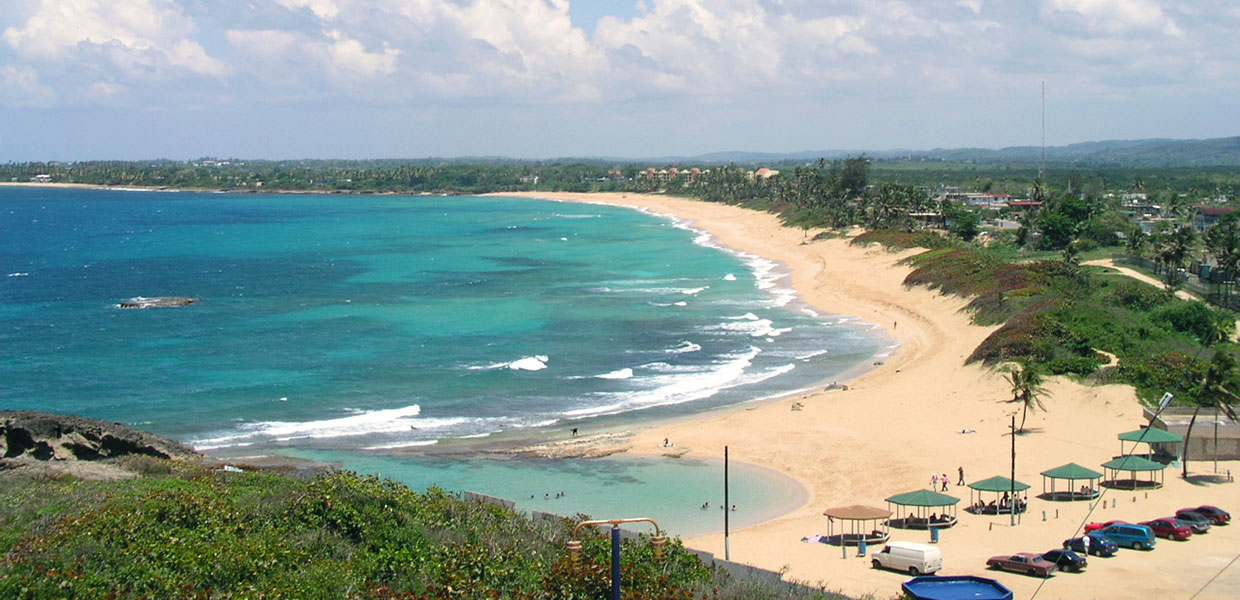
Arecibo, Puerto Rico
Captain Correa Villa
 Arecibo (ah-re-SEE-boh) is known as “La Villa del Capitán Correa” (“The Town of Captain Correa”) in honor of the heroic deeds of Antonio de los Reyes Correa, who defended the town of Arecibo from an English attack in 1702. The Spanish Crown decorated him with the Medal of the Royal Effigy and promoted him to captain. The municipality is located on the northern coast of Puerto Rico, bordering the Atlantic Ocean.
Arecibo (ah-re-SEE-boh) is known as “La Villa del Capitán Correa” (“The Town of Captain Correa”) in honor of the heroic deeds of Antonio de los Reyes Correa, who defended the town of Arecibo from an English attack in 1702. The Spanish Crown decorated him with the Medal of the Royal Effigy and promoted him to captain. The municipality is located on the northern coast of Puerto Rico, bordering the Atlantic Ocean.
The people of Arecibo, known as arecibeños, celebrate several festivals throughout the year, including the patron saint festivities in honor of the Apostle Saint Philip in April and the Arecibo Carnival in February. Arecibo is also known for the traditional Festival del Cetí, celebrated in late November.
The cetí is a tiny fish commonly caught at the mouth of the Arecibo River during the waning moon of July and subsequent waning moons until January. At times, these small fish gather in large schools that can stretch between 25 and 30 meters in length. Thanks to this natural phenomenon, Arecibo is also nicknamed “The City of the Cetí.”
The Arecibo Observatory
For decades, the Arecibo Observatory was the world’s largest radio telescope, with a 305-meter (1,000-foot) dish located in the Esperanza neighborhood. Built by the U.S. Army Corps of Engineers, it was inaugurated in November 1963 under the direction of Prof. William E. Gordon of Cornell University.
Its geographic location, approximately 18 degrees north of the equator, made it ideal for observing the Sun, planets, and other celestial bodies. From this site, scientists made major astronomical and atmospheric discoveries, including the first confirmation of a binary pulsar system (which earned the 1993 Nobel Prize in Physics).
However, after suffering severe structural damage, the telescope collapsed on December 1, 2020. The structure was safely dismantled by the National Science Foundation (NSF). In its place, the Arecibo C³ Center (Center for Culturally Relevant and Inclusive Science Education, Computational Skills, and Community Engagement) is being built, set to open in 2025.
Plans are also underway for the Next Generation Arecibo Telescope (NGAT), featuring advanced radio astronomy and atmospheric radar technology.
History and Foundation
Arecibo has existed as a populated area since the early 16th century (around 1533). By 1570, the Indigenous people assigned to Spanish settlers had already formed a small village.
According to tradition, the name “Arecibo” derives from a Taíno chief named Arazibo, although historian Francisco M. Cadilla questioned this version, suggesting instead that the name comes from the Arecibo River, mentioned by chronicler Antonio de Herrera.
In 1614, under the administration of Governor Felipe de Beaumont, the village was elevated to the status of a town under the name San Phelipe del Arecibo. In 1778, it was declared a Villa (town), and in 1850, it received the honorary title “Muy Leal” (“Most Loyal”).
Arecibo is also remembered for the heroic defense on August 5, 1702, when Lieutenant Antonio de los Reyes Correa and a small militia repelled an attack by 40 armed Englishmen, killing 22 enemies while losing only one man and suffering three injuries among the locals. His bravery earned him a promotion to captain and a medal from the Spanish Crown.
Location
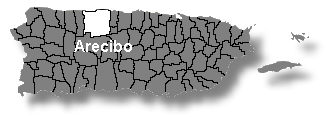 The municipality of Arecibo is on Puerto Rico’s northern coast. It borders the Atlantic Ocean to the north, Utuado and Ciales to the south, Barceloneta and Florida to the east, and Hatillo to the west.
The municipality of Arecibo is on Puerto Rico’s northern coast. It borders the Atlantic Ocean to the north, Utuado and Ciales to the south, Barceloneta and Florida to the east, and Hatillo to the west.
Area
Approximately 326.2 km²
Population
(2020 Census): 87,754 inhabitants
Population Density
Around 269 inhabitants per km²
Demonym
Arecibeños
Nicknames
La Villa del Capitán Correa (The Town of Captain Correa)
Muy Leal (The Most Loyal)
Ciudad del Cetí (The City of the Cetí)
Diamante del Norte (The Diamond of the North)
Los Capitanes (The Captains)
Districts (Barrios): Arecibo, Puerto Rico
Arecibo is divided into 19 barrios: Pueblo, Arenalejos, Arrozal, Cambalache, Carreras, Domingo Ruiz, Dominguito, Esperanza, Factor, Garrochales, Hato Abajo, Hato Arriba, Hato Viejo, Islote, Miraflores, Río Arriba, Sabana Hoyos, Santana, and Tanamá.
Sabana Hoyos is one of the largest and most populated barrios, with over 10,000 residents. Hato Arriba has around 8,000 inhabitants, while Miraflores exceeds 5,000.
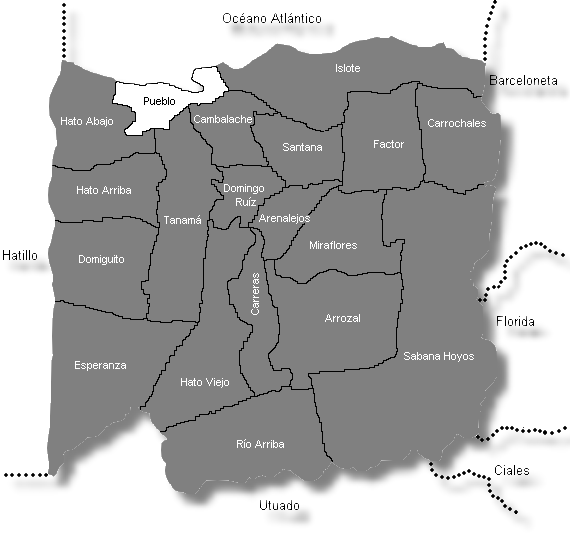
| Censo 2020: Population by Districts (Barrios) - Arecibo |
Population |
| Arecibo Town | 7,077 |
| Arenalejos | 2,997 |
| Arrozal | 1,006 |
| Cambalache | 77 |
| Carreras | 977 |
| Domingo Ruíz | 3,444 |
| Dominguito | 4,998 |
| Esperanza | 2,130 |
| Factor | 6,819 |
| Garrochales | 2,366 |
| Hato Abajo | 22,597 |
| Hato Arriba | 7,947 |
| Hato Viejo | 2,045 |
| Islote | 6,080 |
| Miraflores | 5,318 |
| Río Arriba | 503 |
| Sabana Hoyos | 10,745 |
| Santana | 4,857 |
| Tanamá | 3,413 |
| Total | 87,754 |
Source: U.S. Census Bureau, 2020 Census
Patron:
San Felipe Apostol
Parroquia San Felipe Apostol
P.O. Box 577, Arecibo, Puerto Rico 00613-0577
Tel. (787) 878-1149
Mass Schedule:
Daily: 6:15am, 7:30am, 12:00pm
Saturday: 7:00am, 4:00pm
Sunday: 7:00am, 8:30am, 11:00am
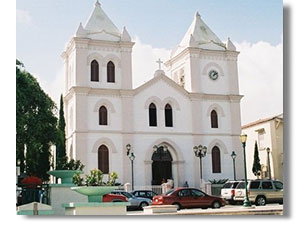
Topography
Arecibo’s terrain is mostly flat, with gentle hills toward the south. Loma Correa, in the Sabana Hoyos barrio, reaches about 270 meters (886 feet) above sea level.
The municipality lies within Puerto Rico’s Northern Coastal Plains, a fertile lowland adjacent to the Northern Karst System, known for its caves, sinkholes, underground rivers, and limestone hills (mogotes). This natural system is one of the Caribbean’s most ecologically and geologically significant regions.
Hydrography
Several rivers and bodies of water enrich Arecibo’s natural environment, most notably:
- Río Grande de Arecibo – Originates in Monte Guilarte (Adjuntas) and flows into the Atlantic Ocean. It’s one of Puerto Rico’s longest rivers.
- Río Tanamá – Begins in Utuado and flows through Esperanza, Dominguito, Hato Arriba, and Tanamá barrios, joining the Río Grande de Arecibo.
These rivers and their tributaries form valuable ecosystems with caves, canyons, and recreational areas like Tanamá River Adventure Park and Cambalache State Forest.
Climate
Arecibo has a humid tropical climate year-round.
- Average Annual Temperature: 25.5°C (77.8°F)
- Average Annual Rainfall: 1,345 mm (approx. 53 inches)
- Rainiest Months: April, May, and September
Due to its coastal location, the municipality occasionally experiences swells and heavy rains during hurricane season (June–November), along with Atlantic trade winds.
Main Industries
Arecibo’s economy is diverse, based on manufacturing, commerce, and services.
- Manufacturing: textiles, electrical and electronic products, chemicals, and medical devices.
- Commerce & Services: retail, education, health, and public services employ much of the population.
- Agriculture & Fishing: small-scale farming and artisanal fishing (including cetí fishing).
- Tourism: eco, cultural, and adventure tourism have grown in recent years, with attractions such as beaches, caves, the Faro de los Morrillos, the former Arecibo Observatory, and Cueva del Indio.
Culture
Known as “The Diamond of the North,” Arecibo’s cultural life thrives with patron saint festivities in May honoring Saint Philip the Apostle, along with music and food festivals. The Teatro Oliver, Arecibo Museum of Art and History, and the colonial architecture around the main square showcase the city’s cultural and artistic heritage.
Education and Science
Arecibo was home to the world-famous Arecibo Observatory until its collapse in 2020. Today, the site remains a hub for scientific and educational initiatives led by the National Astronomy and Ionosphere Center (NAIC), focusing on space and environmental sciences.
The city also hosts the University of Puerto Rico at Arecibo (UPRA) and other higher education institutions that contribute to the region’s academic and technological development.
Recent Trends
In recent years, Arecibo has experienced economic and tourism revitalization driven by:
- Expansion of renewable energy projects and community microgrids.
- Growth in eco-tourism and cultural tourism promoting caves, nature reserves, and Taíno heritage.
- New coastal and climate-resilience infrastructure investments.
- A surge in local entrepreneurship related to food, art, and hospitality.
- Municipal efforts to restore the historic downtown and attract visitors to the city center.
Arecibo continues to emerge as a key destination in northern Puerto Rico — where history, science, and innovation converge to shape a sustainable and culturally vibrant future.
Flag
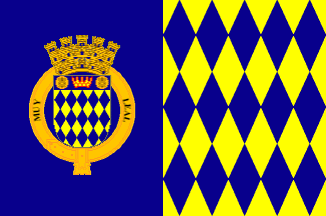 Arecibo’s flag is derived from its coat of arms and retains its symbolism. It is vertically divided into two equal parts:
Arecibo’s flag is derived from its coat of arms and retains its symbolism. It is vertically divided into two equal parts:
- The hoist side is blue, and the fly side is yellow.
- The yellow half displays fifteen rhombuses arranged in five rows of three, touching at their vertices.
- The city’s coat of arms may be placed in the blue area when not used separately.
- Official proportions: three units high by three-quarters long.
The colors and shapes reflect the city’s historical heritage and noble character.
Coat Of Arms
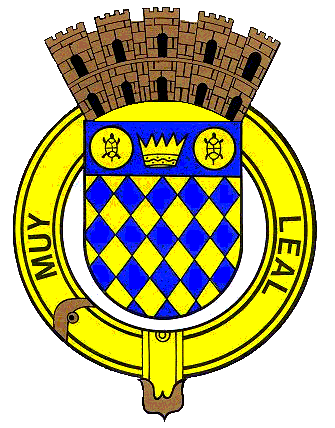 Arecibo’s coat of arms combines Taíno, colonial, and heraldic elements representing its Indigenous heritage, Spanish foundation, and local heroes.
Arecibo’s coat of arms combines Taíno, colonial, and heraldic elements representing its Indigenous heritage, Spanish foundation, and local heroes.
It features blue and gold lozenges and a blue upper band with a five-point open crown decorated with a Taíno-style design.
- The ancient crown honors the Taíno chief Francisco Jamaica Arecibo, who converted to Christianity and ruled the Abacoa region (now Arecibo).
- The two turtles symbolize antiquity and endurance, marking Arecibo as one of Puerto Rico’s four oldest settlements.
- The golden lozenges come from the arms of Governor Felipe de Beaumont y Navarro (1614–1620), associated with the town’s official foundation in 1616.
- The golden belt with a silver buckle represents the local hero Captain Antonio de los Reyes Correa, famed for defending Arecibo in 1702.
- The belt bears the inscription “Muy Leal” (“Most Loyal”), granted by the Spanish Crown in 1850.
- The mural crown with four towers symbolizes its official title of Villa granted in 1778.
Places of Interest
- Cueva del Indio Beach – famous for Taíno petroglyphs and rock formations.
- Poza del Obispo Beach – popular natural pool protected by reefs.
- Caza y Pesca Beach – ideal for fishing and leisure.
- El Muelle Beach (El Faro Beach) – historic lighthouse area.
- Caracoles Beach (La Poza de Don Guelo or Gasolina Beach) – popular local recreation spot.
- San Felipe the Apostle Cathedral – 19th-century architectural gem.
- Faro de los Morrillos Museum – cultural site with panoramic views.
- Arecibo Observatory – internationally renowned for its contribution to radio astronomy until 2020.
- Cambalache State Forest – perfect for camping and mountain biking.
- Arecibo Olympic Pool – sports facility.
- Los Negritos Beach – family-friendly beach area.
Events
- Arecibo Carnival – February
- Bicycle Competition – January
- San Felipe Apóstol Patron Saint Festival – May
- Folkloric Festival – July
- Beach festival – July
- Artisan Fair – September
- Cetí Festival – November
- Centennial of the Puerto Rican Flag – December
Distinguished Citizens
- María Cadilla de Martínez (1884-1951) – Teacher, painter, essayist, historiographer, poet, short story writer, folklorist and feminist. In the literary world, she was known as ‘María de América’ and was internationally recognized as a “pioneering and most important figure in Puerto Rican folklore.” She published a series of books, including: Poesía popular en Puerto Rico (1933), Costumbres y tradiciones de mi tierra (1938), Juegos y canciones infantiles de Puerto Rico (1940), and Alturas paralelas (1941).
- Luisa Capetillo Perone (1883-1922) – Feminist, writer and labor union activist. She was the first woman to wear pants in public in Puerto Rico. She belonged to the Free Federation of Workers and wrote essays, short stories and plays. Among her books are: Ensayos Libertarios (1907), Mi opinión (1911) and Influencias de las ideas modernas (1916).
- Cayetano Coll y Toste (1850-1930) – Physician, poet, politician, journalist, essayist and historian. He studied medicine at the San Juan Council Seminary and surgery at the University of Barcelona. He began working as a journalist in Spain by founding the Revista Ramillete, of which he was editor. He was medical director at the Hospital de la Monserrate in Arecibo and the Home for Orphan Children, which he founded. His literary production displays great versatility. He published the following books: Boletín histórico de Puerto Rico, Crónicas de Arecibo, Colón en Puerto Rico, Historia de la instrucción pública en Puerto Rico hasta el año 1898, Leyendas y tradiciones puertorriqueñas, and others.
- René Marqués (1919-1979) – Playwright, short story writer, novelist and essayist. The prolific writer was the author of the plays La carreta, Los soles truncos and Mariana o el alba, as well as a book of stories, En una ciudad llamada San Juan, the novels La víspera del hombre and La mirada, and the essay “El puertorriqueño dócil”.
- Manuel Zeno Gandía (1855-1930) – Physician, writer, journalist, politician and novelist. He severely criticized the society of his time in a series of novels titled Crónicas de un mundo enfermo, which consisted of La charca (1894), Garduña (1896) and Redentores (1899).
Public Schools sorted by educational levels.
Arecibo Region
Arecibo District
| Name | Level | Telephone | Address |
| Elementary | |||
| ANGÉLICA GÓMEZ DE BETANCOURT | K-6 | (787) 878-1675 | PO Box 116, P.R. 00613-0000 |
| ANTONIA SÁNCHEZ | K-3 | (787) 880-0262 | PO Box 905, P.R. 00613-0000 |
| CARMEN M ABREU | K-6 | (787) 878-8367 | 152 Calle Delfín Olmo, P.R. 00612-0000 |
| COTTO (ANEXO) | EE | (787) 878-8160 | PO Box 9582, P.R. 00613-9582 |
| DOLORES GÓMEZ DE ROMÁN | PK-6 | (787) 878-2425 | PO Box 733, P.R. 00613-0000 |
| DOMINGO RUIZ | K-4 | (787) 816-1919 | PO Box 193, P.R. 00613-0000 |
| DR. FRANCISCO SUSONI | K-6 | (787) 878-1734 | PO Box 193, P.R. 00613-0000 |
| FÉLIX ROSARIO RÍOS | K-6 | (787) 881-5310 | PO Box 1320, P.R. 00688-1320 |
| FRANCISCO PACHÍN MARIN | K-6 | (787) 878-2019 | Urb. Vista Azulo Calle 17, P.R. 00612-0000 |
| FRANKLIN D. ROOSEVELT | PK-6 | (787) 878-3034 | PO Box 1116, P.R. 00612-0000 |
| JESÚS SIVERIO DELGADO | K-6 | (787) 881-3090 | PO Box 907 Garrochales, P.R. 00652-0000 |
| JOHN W. HARRIS | K-6 | (787) 878-1514 | PO Box 9773, P.R. 00613-0000 |
| JULIO SEIJO | K-6 | (787) 878-2062 | PO Box 143566, P.R. 00614-0000 |
| JUSTINIANO TORRES | K-4 | (787) 881-6985 | PO Box 451, P.R. 00613-0000 |
| LOS CAÑOS | K-6 | (787) 879-1558 | PO Box 9919, P.R. 00613-0000 |
| MARIA CATALINA TEJADA | K-6 | (787) 881-6264 | PO Box 1222, P.R. 00616-0000 |
| MARTÍN DIEGO DELGADO | K-6 | (787) 878-0645 | Calle 8 University Gardens, P.R. 00612-0000 |
| VÍCTOR ROJAS II | PK-6 | (787) 878-5969 | PO Box 142716, P.R. 00614-0000 |
| VILLA SERENA | K-6 | (787) 879-4825 | PO Box 9941, P.R. 00613-0000 |
| Intermediate | |||
| JOSÉ GUALBERTO PADILLA | 7-9 | (787) 878-2818 | PO Box 9395, P.R. 00613-0000 |
| LUIS MUÑOZ MARÍN | 7-9 | (787) 880-0757 | PO Box 1116, P.R. 00613-0000 |
| PRE-VOCACIONAL JOSÉ LIMÓN ARCE | EE | (787) 878-3300 | PO Box 152, P.R. 00612-0152 |
| THOMAS JEFFERSON | 7-9 | (787) 878-3332 | MSC 456 P.O.BOX 4035, P.R. 00614-0000 |
| VÍCTOR ROJAS I | EE | (787) 880-3551 | PO Box 9666, P.R. 00612-0000 |
| Secondary | |||
| LUIS MUÑOZ RIVERA | 1-12 | (787) 878-3585 | PO Box 2854, P.R. 00613-0000 |
| Jr. High | |||
| DDR CAYETANO COLL Y TOSTÉ | K-9 | (787) 881-5429 | PO Box 992, P.R. 00616-0000 |
| EUGENIO MARIA DE HOSTOS | K-9 | (787) 881-3540 | PO Box 451, P.R. 00613-0000 |
| JOSÉ RAMON RIVERA | K-9 | (787) 881-1717 | PO Box 451, P.R. 00613-0451 |
| LUIS FELIPE PÉREZ | K-9 | (787) 880-7488 | PO Box 140538, P.R. 00614-0000 |
| SU DIEGO BRAVO | K-9 | (787) 880-2444 | PO Box 2284, P.R. 00613-2284 |
| SU ENRIQUE DE JESÚS BORRAS | K-9 | (787) 878-7699 | PO Box 141165, P.R. 00613-0000 |
| SU FEDERICO DEGETAU | PK-9 | (787) 881-1524 | PO Box 141918, P.R. 00612-0000 |
| SU MANUEL RUIZ GANDIA | K-9 | (787) 879-0851 | PO Box 9937, P.R. 00613-0000 |
| SU RAMÓN E BETANCES | K-9 | (787) 881-2650 | PO Box 995, P.R. 00616-0000 |
| SU RÍO ARRIBA | K-9 | (787) 880-6003 | PO Box 905, P.R. 00613-0000 |
| High School | |||
| ABELARDO MARTÍNEZ OTERO | 10-12 | (787) 879-2614 | PO Box 9059, P.R. 00612-0000 |
| DRA. MARIA CADILLA DE MARTÍNEZ | 10-12 | (787) 878-3480 | PO Box 1118, P.R. 00612-0000 |
| SUPERIOR VOCACIONAL | 10-12 | (787) 880-6696 | PO Box 601, P.R. 00613-0601 |
| TRINA PADILLA DE SANZ | 10-12 | (787) 878-1365 | PO Box 142672, P.R. 00612-0000 |
| All Levels | |||
| BELLAS ARTES | 3-12 | (787) 881-2882 | PO Box 524, P.R. 00613-0524 |
| LIBRE DE MÚSICA | K-12 | (787) 879-3567 | PO Box 2794, P.R. 00613-2794 |
Hymn:
By José A. Monrouzeau
Villa y ciudad te conocí
acariciada por el mar
prodigio es ver cerca de tí
ríos formandose un collar
porque eres tú cuna gentil
de nuestro gran Pachín Marín,
Víctor Rojas también
de Campeche un jardín,
del Capitán Correa, el invicto,
fué un edén.
Arecibo, Arecibo
yo nunca te podré olvidar,
pueblecito de mis amores
que como tú no hay otro igual.
Por tus atletas y tus héroes
tus hijos te saben querer,
con sus mujeres en sus quereres
gratos recuerdos del ayer.
En el baseball estrellas son
Rodríguez Olmo con Pellot.
En basketball gran sensación
con John Padilla en Nueva York.
Así también cual campeón
Petaca Iguina es colosal.
Nuestros atletas son bravos
por su ideal por eso
gozan de fama y admiración.
Arecibo, Arecibo
yo nunca te podré olvidar,
pueblecito de mis amores
que como tú no hay otro igual.
Por tus atletas y tus héroes
tus hijos te saben querer,
con sus mujeres en sus quereres
gratos recuerdos del ayer.

